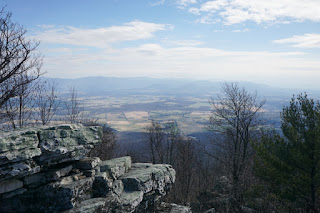Yesterday, we had a spring storm that started out with gross, cold rain. It quickly changed over to snow. It didn't amount to much in the DC area and, even in the mountains, it wasn't expected to be more than a couple of inches. That meant snowshoeing was out. This weekend is also time change, which meant that we would have to drag ourselves out of bed earlier than usual, too. We ultimately decided to do a hike we hadn't done in several years: Signal Knob. The hike starts in a large parking lot that often fills near Elizabeth Furnace in the Massanutten area.
When we pulled in, there was one other car in the parking lot. Not a bad start. It was 16 degrees with the promise of temperatures rising to near 40. The trail was covered with an inch or two of snow and the steady climb was a welcome way to warm cold fingers. There were a few tracks on the trail, which ended at the first campsite. Someone had clearly been up either camping or just enjoying a campfire the night before. It would have been chilly night to be out! After that, we were the first people on the trail today. We saw and heard our first Pine Warblers of the year, which was a welcome sign that spring is coming!
At Signal Knob, we found a relatively sheltered spot to eat some lunch. There was more of a breeze that was ideal and it was still pretty cold. At this point, we were kind of marveling that we hadn't seen anyone so far. When we've done this hike, in the past, we've backtracked from Signal Knob to the Meneka Peak Trail and hiked south on that to catch the Tuscarora. This time, we decided to continue on the Massanutten Trail and connect with the Tuscarora in the valley below to the west. While this meant an extra climb, the distance was the same and it kept us out of the wind on the ridge. The hike down to the Tuscarora Trail went quickly on the road. From there it is steep climb back up to the top of the ridge. We quickly shed the layers we had put on at lunch.
From the junction with the Meneka Peak Trail back to the car is four winding miles. By this time, most of the snow had melted off of the trail and there were definitely some muddy patches. It was a pleasant walk down, though and we saw no one until we reached the parking lot. It was a really good day. All said and done, 10 miles.
The view northwest from Signal KnobLeaves frozen into the ice on the Massanutten Trail near the junction with the Tuscarora
A relatively poor photo of a lenticular cloud west of us. I forgot the battery for my good camera, so all I had was my cell phone.
Bird tracks in the snow
The Tuscarora Trail below Meneka Peak
Perfect blue sky
A bird nest from last year. It looks like it might be a Red-Eye Vireo nest.

















































